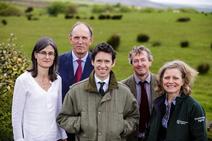A €16 million project that will help protect and transform moorlands across the South Pennines and the Peak District National Park has been officially launched.

Defra Minister Rory Stewart was joined by Acting Chair of the Environment Agency, Emma Howard Boyd, Natural England Chairman Andrew Sells and Sarah Fowler Chief Executive of the Peak District National Park Authority to celebrate the start of the five-year MoorLIFE 2020 project.
The Minister said: “Funding provided from the EU to the Moors for the Future Partnership, will ensure the protection of our distinct landscapes and priority international habitats across the South Pennines.
“Through partnership working, crucial conservation and scientific work, alongside innovative techniques, we can fully understand and protect our moorland habitats for future generations.”
Sarah Fowler, Chief Executive of the Peak District National Park, said: “MoorLIFE 2020 is a significant partnership project putting life back into this unique and beautiful moorland landscape.”
The project, hosted by the Peak District National Park Authority, will enable the team at Moors for the Future to continue the progress that has been made over the past 12 years, protecting huge areas of the internationally important South Pennine Moors.
The start of this work followed 25 years of research work by the Peak District Moorland Management Project and rests on early experimental work undertaken by the landowning community and the current moors for the Future partners.
The funding for MoorLIFE 2020 includes €12 million from the EU’s LIFE fund, as well as significant contributions from three major utility companies, Severn Trent Water, United Utilities and Yorkshire Water.
The blanket bogs of the South Pennine Moors Special Area of Conservation (SAC) are at significant risk, with large areas devastated by 150 years of atmospheric pollution and wildfires.
Expanses of bare peat threaten the remaining active blanket bog, which plays a key role in the UK’s action on climate change, together with providing resilience to natural disasters such as floods and fire and providing drinking water to the towns and cities around the Peak District.
The €16 million of funding will enable the partnership to expand its work hugely, protecting the integrity of 9,500 hectares of active blanket bog through re-vegetating bare peat, improving hydrology and diversifying existing vegetation.
Chris Dean, Moors for the Future Partnership Manager, giving an insight into the scale of the works said: “We will be restoring 8.5 sq km of bare peat, blocking 108 km of erosion gullies as well as conducting a fantastic amount of research and monitoring.”
The Peak District National Park Authority will be acting as the co-ordinating partner. Other partners, who will also benefit from the new funding, as well as leading on some of the actions, are the National Trust and RSPB, which own or manage large tracts of moorland in this area, and Pennine Prospects (the South Pennines Rural Regeneration Company).
The wider benefits of moorland restoration are:
- enriching biodiversity – providing breeding habitats for moorland plants, birds, insects, mammals and amphibians, many of which are in serious decline
- improving water quality in our reservoirs and rivers as less sediment pours into streams
- reducing fire risk as wetter moorlands resist the spread of wildfires – which release tonnes of carbon into the atmosphere and devastate wildlife habitats
- retaining carbon in the soil – a major factor in action on climate change. Peatlands are the UK’s biggest carbon store, holding 40-50 per cent of its carbon, but bare, damaged peat releases it to the wind
- reducing flood risk in towns and villages as revegetated moorland reduces the flow-rate and volume of downpours into our rivers and streams
- boosting the local economy by attracting more visitors, many of whom use local holiday accommodation, shops, cafes and pubs
For more information about the EU LIFE programme, go to: